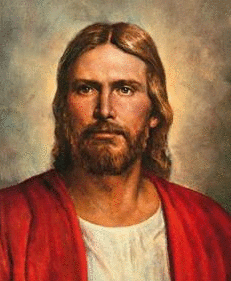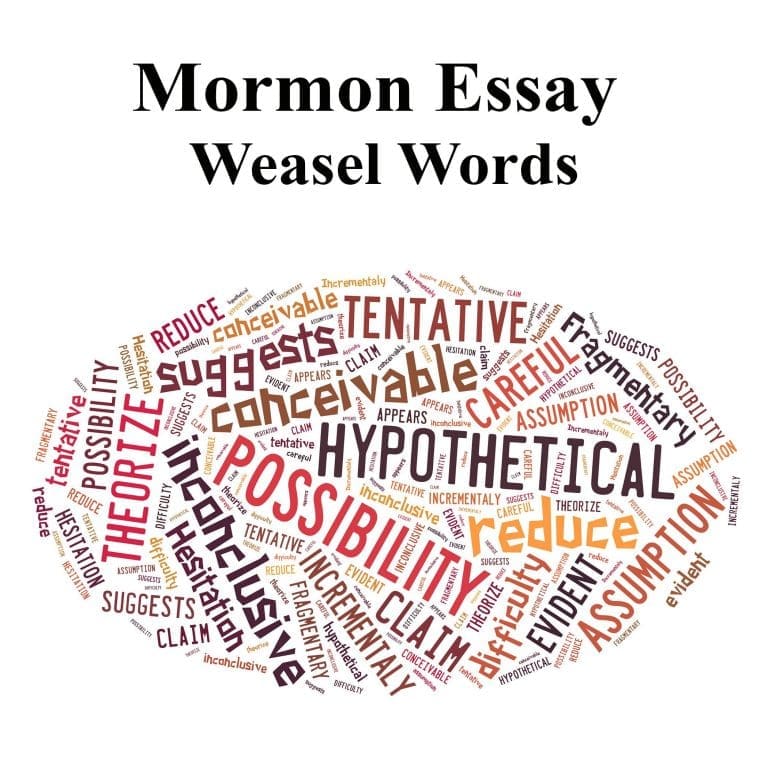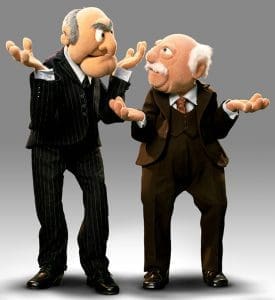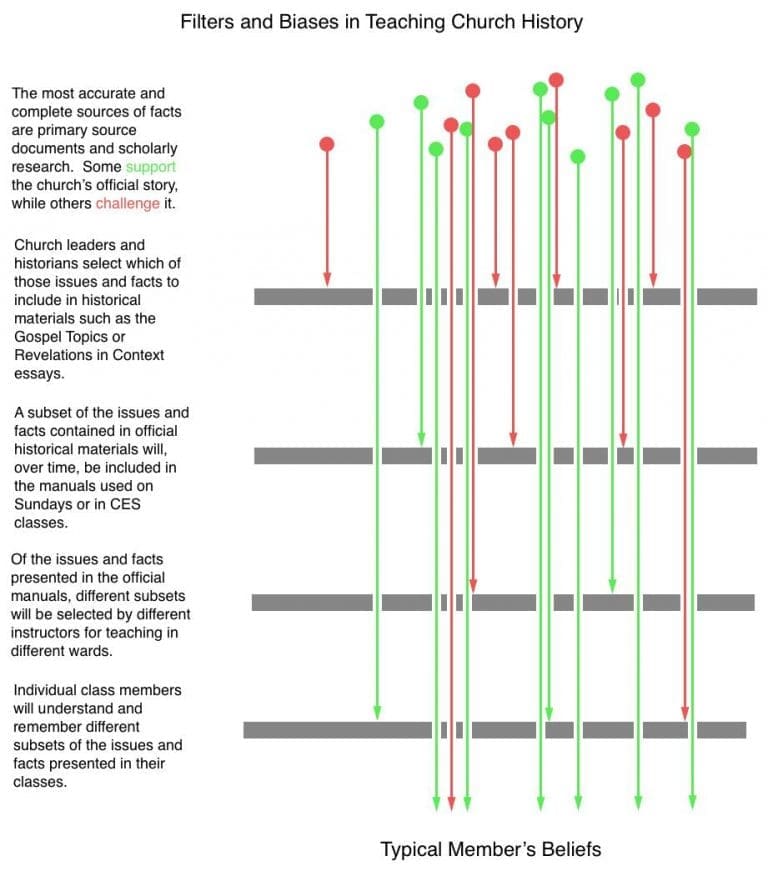Many of the founders and early leaders of the LDS Church claimed that truth and sincere questioning were important to the faith. Today however, faced with the power of the Internet and the increased transparency the information revolution has ushered into society, the LDS Church remains committed to simplistic narratives that scholars and the historical record have shown to be questionable or demonstrably false. The Church continues to persecute or marginalize scholars and members who publicly inquire about its authority and foundational truth claims.
Seeking truth in Mormonism remains fraught with peril, as the eternal salvation of the entire family hangs in the balance. Current LDS leaders appear to be ramping up their fear-based rhetoric, such as when the prophet Russell Nelson declared in April 2020 that “The time is coming when those who do not obey the Lord will be separated from those who do.” As Mormons clearly understand that to follow the Lord, one must follow the prophets, such assurances of safety and security merely serve to reinforce the LDS patriarchal authority structure.
LDS ENCOURAGEMENT OF INVESTIGATION
Mormonism once prided itself on its scientific principles, suggesting that faith in its claims simply made more sense than other religions. Earlier generations of Church leaders encouraged intellectual honesty, while modern leaders have tended towards a different tact, asking members to “doubt your doubts before you doubt your faith.”
Prophet John Taylor wrote in the late 1800s, “I think a full, free talk is frequently of great use; we want nothing secret nor underhanded, and I for one want no association with things that cannot be talked about and will not bear investigation.” [1] Apostle George A. Smith argued similarly, “If a faith will not bear to be investigated, if its preachers and professors are afraid to have it examined; their foundation must be very weak.” [2] Such admirable openness harkens back to Joseph Smith’s claim that all truths belong to Mormonism.
Apostle Orson Pratt wrote “… convince us of our errors of doctrine, if we have any, by reason, by logical arguments, or by the Word of God, and we will be ever grateful for the information, and you will ever have the pleasing reflection that you have been instruments in the hands of God of redeeming your fellow beings from the darkness which you may see enveloping their minds.” [3]
Influential LDS intellectual and Apostle James E. Talmage wrote, “The man who cannot listen to an argument which opposes his views either has a weak position or is a weak defender of it. No opinion that cannot stand discussion or criticism is worth holding. And it has been wisely said that the man who knows only half of any question is worse off than the man who knows nothing of it. He is not only one sided, but his partisanship soon turns him into an intolerant and a fanatic. In general it is true that nothing which cannot stand up under discussion and criticism is worth defending.” [4]
Even deep into the twentieth century, Apostle Hugh B. Brown wrote, “We should be scientific – that is, open-minded, approaching new problems without prejudice, deferring a decision until all the facts are in.” [5] Brown continued with, “I admire men and women who have developed the questing spirit, who are unafraid of new ideas as stepping stones to progress. We should, of course, respect the opinions of others, but we should also be unafraid to dissent – if we are informed. Thoughts and expressions compete in the marketplace of thought, and in that competition truth emerges triumphant. Only error fears freedom of expression.” [6] This spirit of healthy questioning, an eagerness to learn and a willingness to be corrected, is so different than what members hear today. Too often, those of a questing spirit are drummed out of the LDS Church.
LDS Historian Leonard Arrington wrote in the 1970s, “The attempt to suppress problems and difficulties, the attempt to intimidate people who raise problems or express doubts or seek to reconcile difficult facts, is both ineffective and futile. It leads to suspicion, mistrust, the condescending slanting of data. The more we deny or appear to deny certain demonstrable ‘facts,’ the more we must ourselves harbor serious doubts and have something to hide.” [7] Arrington tried but ultimately failed to make the LDS church more transparent; and that failure significantly contributed to the problems the LDS Church faces today.
CHURCH SPONSORED ART

Few aspects of Mormonism are spared from the perils of truth seeking. Images help to create powerful mental visualizations. As one navigates a thoughtful exploration of the Book of Mormon and other LDS truth claims, it is important to recognize that nearly every piece of Church-promoted art contains an idealized and, in many cases, false narrative, including the sailing ship, swords, armor, massive walled cities, horses, Joseph Smith openly scrutinizing gold plates on a table, the 8 witnesses gathered together in one place, etc. Established history and the Church’s own records refute their own images.
This painting of Jesus Christ, by LDS artist Del Parson, was widely rumored to be the most accurate depiction of The Lord ever created. The LDS Apostles were said to have been consulted for numerous edits and improvements. The Church allowed this inspiring narrate to informally propagate. However, upon closer examination, it seems apparent that Del relied upon his own strong facial features, rather than divine intervention.

LAMENTING LOSS OF CONTROL

Apostle Russell M. Ballard openly admitted in 2016 that the LDS Church has been taken off guard by the Internet. In the good ol’ days, he argues, “Few students came in contact with alternative interpretations… It was only a generation ago that our young people’s access to information about our history, doctrine, and practices was basically limited to materials printed by the Church. Few students came in contact with alternative interpretations. Mostly, our young people lived a sheltered life.” This statement seems disingenuous, considering how hard Ballard and his contemporaries worked to shelter so many Mormons from factual Church history.
Ballard went on to instruct the Church’s seminary teachers to inoculate students with church-approved and faith-friendly interpretations of challenging issues like polygamy, seer stones, conflicting First Vision accounts, Book of Mormon historical challenges, Book of Abraham issues, etc. However, the church-approved essays on controversial topics often raise more questions than they can answer in the desired faith-affirming way. [8]
The days Russell M. Ballard speaks of, the days when the Church controlled and limited available information, are on display in Elder Boyd Packer’s infamous The Mantle Is Far Far Greater Than The Intellect. Packer’s talk casts doubt on intellectual rigor and stands as one of the most infamous assaults on scholarly inquiry within the Mormon tradition. Packer stated: “I have a hard time with historians because they idolize the truth. The truth is not uplifting; it destroys…Historians should tell only that part of the truth that is inspiring and uplifting.” [9] Even today, this sentiment of suppression remains a common thread among many of the modern apostles and prophets of the LDS Church, and ushered them directly into the problems they are experiencing as members increasingly encounter inconvenient truths.
Elder Dallin Oaks pushed the embargo on dissent even further, asserting that “it is wrong to criticize leaders even if the criticism is true.” The command remains as relevant today among the majority of faithful LDS members as when it was first delivered over three decades ago. The whole truth no longer seems to be of interest to LDS Church leaders, as loyalty and unquestioning obedience are more often what members are taught.
LDS INSTRUCTED NOT TO RESEARCH THE RELIGION
While addressing members in the Chicago area on February 4, 2019, President Dallin Oaks acknowledged that doctrinal issues have led some to inactivity. He counseled, “I suggest that research is not the answer” to the problems with LDS church history. The fact that the man second only to President Russell M. Nelson would say such a thing in the midst of the Internet age is astonishing. Many of the Church’s younger members are used to sharing information and fact checking claims of all kinds online. It sounds suspicious to them when their church asks for special consideration regarding its unique truths, which is one reason why so many are leaving.
TRUST NO ONE
In 1999, Russell M. Ballard reiterated the Church’s appeal to unique authority, “We can accept nothing as authoritative but that which comes directly through the appointed channel, the constituted organizations of the Priesthood, which is the channel that God has appointed through which to make known His mind and will to the world. …by sponsoring symposia, books, and journals whose contents challenge fundamental doctrines of the Church. False prophets and false teachers are those who declare that the Prophet Joseph Smith was a duplicitous deceiver; they challenge the First Vision as an authentic experience. They declare that the Book of Mormon and other canonical works are not ancient records of scripture.” [10] Perhaps the tone of this talk and its insistence upon there being only one approved source of information was acceptable to the prior generation, but it is increasingly less palatable to modern members.
By 2016, Ballard had moderated his tone in To Whom Shall We Go? “Where will you go to find people who live by a prescribed set of values and standards that you share and want to pass along to your children and grandchildren? …Where will you go to find others who share your beliefs in personal loving heavenly parents…? The danger comes when someone chooses to wander away.” The fact that he appeals to root fears and subtle LDS cultural cues by focusing exclusively on generic values and standards, rather than addressing the long list of unique LDS truth claims, speaks volumes. While Ballard’s concern is undoubtedly genuine, is the LDS view of the world so narrow that it fails to see or acknowledge the innumerable non-Mormon families and individuals who help build a better world every day?
Furthermore, the LDS Church has continued to the present day in regularly pursuing the excommunication (now called removal of membership) of previously faithful members who become questioning and publicly vocal upon learning uncomfortable truths that contradict official teachings. Regarding excommunication, Spencer W. Kimball instructed, “This is about the saddest thing which could happen to an individual. Better that he suffer poverty, persecution, sickness, and even death. A true Latter-day Saint would far prefer to see a loved one in his brier than excommunicated from the Church.” [11] This is an indoctrination tactic, which discourages the faithful from encountering any truths that may lead them to question what the orthodoxy insists is doctrine.
Dallin H. Oaks wrote, “A lie is not always told in so many words. It may be a creature of concealment or a misrepresentation by action or a half-truth.” [12] Prophet Thomas S. Monson similarly wrote, “Half truths are used to mislead under the representation that they are whole truths.” [13] In pointing the finger at others, they suggest that half-truths originate from those that misrepresent, conceal or speak against the carefully scripted narratives the Church promotes to its members. This is ironic, given that the LDS Church itself has deliberately relied upon those very tactics on the rare occasions when it attempts to address the abundance of inconvenient historical truths. The Church’s proclivity to guard its own history, prompted Leonard Arrington to suggest, “It is unfortunate for the cause of Mormon history that the Church Historian’s Library, which is in the possession of virtually all of the diaries of leading Mormons, has not seen fit to publish these diaries or to permit qualified historians to use them without restriction.” [14]
LDS leaders seem to fear that others will take their self-declared exclusive power to speak truth away from them; a sentiment President Thomas Monson demonstrated when he instructed, “Remember that the power to lead is also the power to mislead; and the power to mislead is the power to destroy.” [15] Though understandable to a degree, it is not something that can be wished away in the modern Internet age. Instead, the modern LDS Church has been chewing up and spitting out its best and brightest scholars, rather than nurturing and encouraging an honest dialogue about its own history.
LEARN MORE
- 150 Years of Truth and Consequences about Mormon History, Quinn, Sunstone, Feb 1992.
- The Hiding of Church History
- Freedom Of Mind – The BITE Model
[1] Prophet John Taylor, Journal of Discourses, vol 20, 264.
[2] Apostle George A. Smith, Journal of Discourses, vol 14, 216.
[3] Apostle Orson Pratt, The Seer, 15-16.
[4] Apostle James E. Talmage.
[5] Apostle Hugh B. Brown, A Final Testimony, from an Abundant Life, 1999.
[6] Apostle Hugh B. Brown, A Final Testimony, from an Abundant Life, 1999.
[7] Leonard Arrington, The Writing of Mormon History, 129.
[8] LDS.org, Opportunities and Responsibilities of CES teachers in the 21st Century, 2016.
[9] Apostle Boyd K. Packer, as related by D. Michael Quinn, “Pillars of My Faith,” talk delivered at Sunstone Symposium, Salt Lake City, August 19, 1994.
[10] Beware False Prophets, M. Russell Ballard, LDS General Conference, Oct 1999.
[11] Spencer Kimball, The Miracle of Forgiveness, 329.
[12]Apostle Dallin Oaks.
[13] Prophet Gordon Hinckley.
[14] Prophet Thomas Monson.
[15] Dialogue: A Journal of Mormon Thought, Spring 1966, 26.


